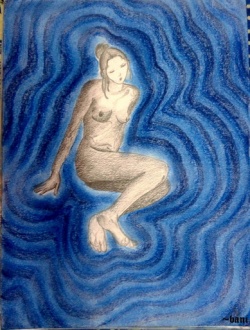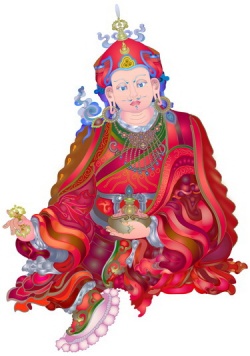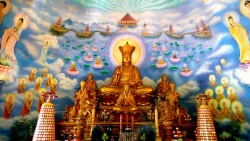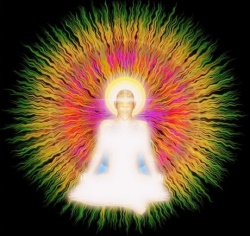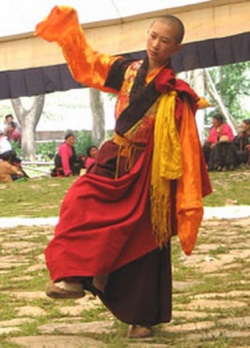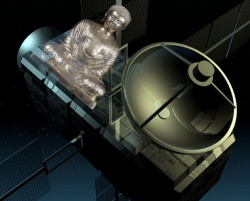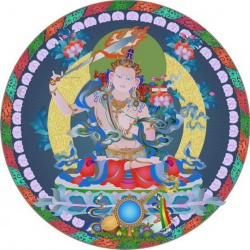The Oath-Bound Deities
The Oath-Bound Deities If you move in Tibetan Buddhist circles, it will not be long before you hear someone talk about their yidam. Especially if they have been meditating for some years, you will gather from the way they talk that it is something of the greatest importance for them. This Tibetan word literally means oath, vow, or promise, and connotes the Buddhist deity to whose meditation you are committed, to whom you are linked by a promise or vow, your main focus of spiritual practice.
Any Buddhist deity can be a yidam. For example, many of the early Kadampa geshes had Tara or Avalokitesvara as theirs. However, the word is sometimes reserved for deities of the anuttarayoga, or Highest Tantra. Initiations into this level of practice require great seriousness on the part of the initiate. When receiving them, one takes various vows and pledges. Some initiations may include a commitment to practise the sadhana every day for life. In this way the initiate is 'bound by oath' to the yidam. In this chapter we shall use the word to refer to the deities of Highest Tantra. These yidams are all embodiments of Tantric teachings, in the same way that the goddess Prajnaparamita came to embody the Perfection of Wisdom literature. Each of them has a Tantric text, or collection of texts, of whose teachings they are the living symbols.
None of them, to the best of my knowledge, is found in the Mahayana sutras. As always with the profusion of forms in the Tantra, there are a great number of these yidams. Here we shall look at just five of the most A Guide to the Deities of the Tantra important, and try to gain a feeling for them as a class.38 In particular we shall concentrate on the yidams Cakrasamvara and Vajrabhairava, as representatives of the two main divisions of Highest Tantra. The tantras of this level can be divided into Mother Tantras, which are primarily concerned with the development of wisdom (Sanskrit prajna), and Father Tantras, which emphasize the development of compassionate skilful means (Sanskrit upaya).
We shall only be able to gain a general feeling for these five yidams - firstly because they are the most complex figures in the whole of Buddhism (both iconographically and in the world-view which they embody). Secondly, some aspects of their practice are genuinely secret, and it would be inappropriate for me to offer too many details about their inner meaning and the way they are meditated upon. Writers on Highest Tantra have to try to tread a 'middle way'. On the one hand, details of these practices are not supposed to be revealed to those who have not received the relevant initiation.
On the other, there has been a general relaxation of secrecy by Tibetan teachers, and it would be ridiculous to ignore the fact that much information has already been published in the West. However, I feel it is wise to err on the side of caution, and I have thought it best to give something of an outsider's view of these figures, even where I might have some personal experience. I have also decided against providing any of the mantras associated with them. The view of existence which the yidams express is more multifaceted than that of other figures. Broadly speaking, we can say that each Buddha or Bodhisattva embodies a particular approach to Enlightenment.
For example, the Green Tara practitioner strives to develop infinite compassion, Vajrapani's is a path of liberating energy, and so on. The yidams, however, are more multidimensional. Rather than one approach to the universe, they present an all-encompassing vision of it. They are complex symbols that have many levels of interpretation, outer, inner, and secret. At the diamond gates of their mandala, we enter a cosmic labyrinth of multiple meanings in which truths echo and re-echo forever. This vision is made more total because, unlike the majority of practices of the Lower Tantras, one aims to keep the meditation going all the time. After the Green Tara sadhana, when we rise from our cushion, the
meditation has had its effect, but we return largely to our old self. Practice of Highest Tantra aims to cut off the old self altogether. At initiation we become the yidam, and we aim to live as the yidam from then on. After finishing the sadhana we get up still trying to maintain the feeling that we are the yidam, that everything we hear is the mantra, and that our environment is our mandala palace and attendant deities. Through transforming ordinary appearances and concepts in this way, we aim to superimpose our meditative vision on every aspect of our lives, to transform them totally. The complex and radical nature of these practices is reflected in the yidams' iconography. Here we move away from a more naturalistic vision to one in which we may encounter twin figures, with perhaps twelve, sixteen, or thirty-four arms.
According to Chogyam Trungpa, many of these forms are based on those of yaksas - powerful spirits of ancient Indian legend - who appear in the sutras. Generally, though, they bear a close resemblance to the Shiva figures of Hinduism. Many of the figures are recognizably human in physique, though some are heavily built. Many are neither peaceful nor wrathful, but somewhere in between - smiling, but also sneering. This semi-wrathful expression suggests a balanced attitude to the world, as though the yidams fuse in themselves the natures of both the peaceful and wrathful Buddhist deities. The yidam is also known as the 'esoteric' Dharma Refuge.
While some of these practices may be genuinely secret, the word 'esoteric' here also suggests something that is a matter of personal experience. The yidams become hardly less esoteric by being unveiled in the West in exhibitions and coffee-table picture books on Tibetan Buddhism. It is only when we enter their mandala, and actually see for ourselves their total vision of the universe with its interplay of energies, that their secrets will be revealed. Why should the yidam be a Dharma Refuge? We have seen that the term 'yidam' can be applied to any Buddhist figure who is the main focus of our meditation and devotion. Let us suppose that the beautiful young female bodhisattva Green Tara is our yidam. We may spend quite a bit of time reading and studying the Dharma, but if for an hour a day, say, we become Tara, in a world of light in which we see the sufferings of sentient beings before us, and play out the drama of rescuing them, and in which everything ends by dissolving into the sky of Emptiness, that is the experience likely to leave the deepest imprint on our minds.
It is contact with the yidam through meditation that will give us the strongest taste, the most direct experience, of the Dharma. It is through our Tara meditation that we take the Dharma into our heart and make it our own. Hence the yidam is the esoteric Dharma Refuge. Heruka Cakrasamvara The tradition of meditating on this yidam is based on the Sri Cakrasamvara Tantra. This tantra has been widely studied by all Tibetan schools, and there are many sadhanas and commentaries associated with Cakrasamvara. He is a yidam of particular importance to the Kagyu school, though as with all the yidams we shall be meeting, devotion to him crosses all sectarian frontiers. His practice is very widespread among the Gelukpas. There is a sadhana known as the Yoga of the Three Purifications of Sri Cakrasamvara' that is quite widely practised at Gelukpa centres in the West.
The first in the line of Cakrasamvara practitioners is generally considered to have been the Indian mahasiddha Saraha. He was a brahmin who had become a Buddhist scholar-monk. However, he was not satisfied by his learning, and set out to find a Tantric teacher. In a market-place he saw a young low-caste woman making arrows. He became deeply engrossed in watching her working, and finally approached her and asked if she made arrows for a living. She replied, 'My dear young man, the Buddha's meaning can be known through symbols and actions, not through words and books.' Her arrow hit its mark. Flouting all convention, Saraha went to live with her, receiving her Tantric teachings. As a result, he became one of the greatest of all Tantric adepts. He is particularly renowned for his dohas or songs, in which he expresses the profound realizations he has gained through Tantric practice. This yidam is known by various names in Sanskrit. Sometimes he is known as Samvara or Sambara, sometimes as Heruka.
In Tibetan he is called Khorlo Demchok or Khorlo Dompa. Here we shall refer to him as Cakrasamvara. Though it literally means 'restraint', samvara is associated, by Tibetan lamas explaining the significance of this yidam, with 'supreme bliss'.39 Cakra (now usually anglicized as chakra) means wheel. It is also the Sanskrit word used for the psychic centres within the body of the meditator, whose manipulation through performing the Cakrasamvara sadhana gives rise to the 'supreme bliss'. As we have seen, texts of Highest Tantra are often classified into Mother and Father Tantras. Mother Tantras emphasize wisdom - particularly the realization of the indivisibility of bliss and Emptiness. They are particularly suited to those of passionate temperament, providing methods of liberating the energy tied up in greed and attachment and making it available for the pursuit of Enlightenment.
Cakrasamvara is a central deity of the Mother Tantra class. He can appear in a number of different forms. Here we shall describe just one very well known and characteristic form. He appears standing on a variegated lotus. Even in this small detail, we see how this world of Highest Tantra differs from the world of the Mahayana occupied by the Buddhas and Bodhisattvas, most of whom were symbolized by one predominant colour. In the world of the yidams we are gazing at an all-encompassing vision, so colours become more varied. He stands on a sun disc, on which lie two figures being trampled underfoot. One foot pins down the black god Bhairava by the back of the neck, the other is placed on the breast of the red goddess Kalaratri. Both figures have four arms, two of which hold a curved knife and a skull cup, while the other two are raised in devotion to the great figures above them.40 Bhairava and Kalaratri are forms of the god and goddess Shiva and Uma. Shiva is one of the most powerful of all Hindu deities.
In later Hinduism he forms one of a triad of gods with Brahma and Vishnu, and is responsible for all the destructive aspects of the universe. Uma is his consort. In the Vajrayana they are incorporated into the Tantric world-view as minor deities who preside over the desire realm. They are symbolically overcome by Cakrasamvara, and raise their hands in submission to the transcendental figures that stand over them. Even the highest forms of the mundane appear puny compared to the majesty of this yidam. His body is deep blue, and he has four faces which gaze out into the four cardinal directions. The face that looks directly at us is blue, the one to our right, green, to our left, yellow, and facing away from us, red. All the faces have crowns of skulls. In his hair, to his left, is a crescent moon. This moon, along with many of the other emblems of Cakrasamvara, is an attribute of Shiva.41 All these Shivaite symbols are given a strictly Buddhist interpretation in the Vajrayana. Here, for instance, the crescent moon symbolizes Bodhicitta which is ever-increasing.
Thus the general suggestion of the figure is of an Enlightened consciousness, having overcome and gone beyond the relatively limited vision represented by Shiva, nonetheless expressing itself through the symbols associated with him. The power of such an image is likely to be largely lost on Westerners. One would perhaps have to imagine Cakrasamvara trampling underfoot the prostrate form of the God of the Old Testament to gain some idea of its potency in India. Cakrasamvara has a tiger-skin draped over his loins, and a garland of freshly-severed heads hangs from his neck. He has no less than twelve arms. A central pair embrace his consort Vajravarahi ('diamond sow'). The two hands cross behind her back, holding a vajra and bell in the vajrahumkara mudra. The right hand with the vajra, and the left with the bell, cross at the wrist, the right arm outermost. His other arms radiate out from his body, forming a rough circle. The right hands, beginning from the top, hold (I) an elephant hide, which is draped across his back, a damaru, an axe, a chopper with a vajra handle, and (5) a trident lance.
His left hands, counting downwards, hold the elephant hide, a khatvanga, or magic staff (similar to the one we saw Padmasambhava holding), (3) a skull cup brimming with nectar, a noose or lasso, and (5) the severed head of the god Brahma, which has four faces. He is locked in sexual embrace with his consort Vajravarahi, who by contrast is quite a simple figure. She is brilliant red, with only one face and two arms. Her right hand, raised aloft, holds either a vajra or a flaying knife (Tibetan drigu) with a vajra handle. Her left hand, embracing her partner's neck, holds a skull cup. She is naked apart from a few bone ornaments, a five-skulled crown, and a garland of skulls which hangs from her neck. In some forms both her legs are wrapped around her partner's thighs, in others her right leg is raised while with her left leg she also tramples on Kalaratri.
The copulating figures are encircled by an aura of flames. The symbolism of these figures is so complex, so labyrinthine, that a guru experienced in the Cakrasamvara system could easily produce a large book on just this one figure. The most important message it conveys is a logic-bemusing union of opposites. Heruka Cakrasamvara and his consort appear from the dimension in which all diversity is unified, and unity displays its endless forms. The two figures on which the mystic pair drum their feet lie separate. They represent the realm of mundane experience in which separation is the rule. It is this separation, experienced by most people as isolation, which fuels desire. Desire urges us to unite, to reach out to overcome separation. But this external seeking gives us at best only temporary relief for our ills.
Eventually we lie separate and alone, in the world of me and you, he and she, good and bad, heaven and hell. Constantly discriminating, reaching out to embrace some experiences and avoiding others, we fail to see that the two parts of all dualities are attached; we cannot grasp one without finding ourselves holding on to the other. Cakrasamvara and his consort unite all opposites in their sexual embrace. They are really one figure, appearing as two. Their union represents different integrated aspects of one Enlightened consciousness. They exemplify what in Tantra is called yuganaddha - 'two-in-oneness'.42 We saw in Chapter One that the female figure, the yum or Mother, is also referred to as the prajna - for she represents wisdom, the intuitive realization of Emptiness.
This wisdom sees the common characteristic of all phenomena: everything is devoid of an unchanging, fixed, self-nature. Everything has the same essential nature, which is 'no-nature'. This wisdom- view applies to everything in the universe. Because nothing has a fixed nature of its own, there are no fixed boundaries or divisions between things. If there are no fixed limits or barriers, if the seemingly static elements of existence can recombine like the colours of oil on water, then there is no separation. Everything is of one empty nature. Hence the yum has only one face, symbolizing this essential sameness of A Guide to the Deities of the Tantra all things. She is naked to symbolize the simplicity and unadorned nature of things in their essence. (In Mother Tantras the female consort is always naked, whereas in Father Tantras the consort always wears some item of clothing - usually just a cloth around the loins.
This indicates that Mother Tantra is mainly concerned with the wisdom that sees the essential emptiness of all forms; Father Tantra emphasizes the compassionate expression of wisdom through form.) In contradistinction to her, the male yab, or Father, represents the compassionate activity of the Enlightened mind - working in the world to awaken beings to their true empty nature. In fact, with his four faces looking into the four directions, and his twelve arms, he symbolizes the world of appearances, the multiplicity of forms. His partner is the unchanging realization of the emptiness of appearances, the sameness of nature of all forms.
Their sexual union suggests the ultimate nondistinction, on the level of absolute truth, between appearances and Emptiness. Their being two figures suggests that distinctions can still be made on the level of relative truth. The twelve arms of the male figure represent correct understanding of the twelve links of conditioned co-production (pratitya samutpada). This basic Buddhist teaching is an application of the principle that all things come into existence dependent on particular conditions, and cease to exist when those conditions change. It applies this general principle to demonstrate the conditions that cause our existence in the circle of samsara, the endless round of unsatisfactory rebirth. These are essentially ignorance of the true nature of existence, which causes us to react to pleasant and unpleasant stimuli with desire or aversion.
This strengthens our involvement with these stimuli, which fixes our view of them and embroils us more deeply in the world of impermanence and hence unsatisfactoriness. In each hand he holds an implement which symbolizes the overcoming of samsara. For example, the elephant hide he holds draped over his back is said to symbolize conquered ignorance, the axe severs the fetters of birth and death, and so on. Thus the two figures represent a vision of a new universe, which we can enter through contemplating them. In this universe, opposites are united without losing their distinct validity on the relative level. Dwelling on Cakrasamvara we gain direct intuitive experience of the highest teachings of the Dharma. The opposites of appearances and emptiness, diversity and unity, samsara and nirvana, compassion and wisdom, discrimination and sameness, relative and absolute, male and female, all fuse in the two ecstatic figures, and this fusion of opposites causes the dawning of great bliss in the mind of the meditator, a bliss of which sexual union can be only an inadequate cipher. There are still more opposites that we can find reconciled in this mystic coupling.
Wrathfulness and peacefulness are reconciled. It is said of the male figure that while outwardly fierce, he is inwardly compassionate, dignified, and serene. More important, we find symbols within symbols. On the level of the overall figures, the male Heruka symbolizes skilful means, while his partner stands for wisdom. However, the yah holds in his front two hands the crossed vajra and bell, which themselves represent conjoined method and wisdom. Again, in the pairing of figures, the yum is receptive, the male active and outgoing. Yet we see that both these attributes are to be found in the female figure alone. Her left arm and side are passive, and in her left hand she holds the skull cup.
Yet her right side is dynamic. With her right leg (in some traditions) she grasps her partner's thigh, and her right hand is thrust upward brandishing aloft the sharp vajra-chopper, or the dynamic vajra, with her hand in the tarjani mudra of warding off demons. From this we can see that yet another pair of opposites has fused: macrocosm and microcosm have become one, and the great truths of the Dharma can be seen in the vast and the infinitesimal. We still have a further step to go before we can grasp even the rudiments of the Cakrasamvara universe. The great yab-yum pair are but the central focus of a vast mandala.
There are a number of important Cakrasamvara traditions, passed down from Indian masters, with mandalas involving different numbers of figures. A common form has sixty-two deities, but some mandalas include several hundred figures altogether. For example, a mandala in the tradition of Maitripada has twelve dakinis, four in an inner circle, and a further eight in an outer ring, of whom four have animal heads and guard the gates of the mandala. All the dakinis are naked like Vajravarahi. They each have four arms, and these hold a knife, skull drum, skull cup, and trident staff. To begin to describe a sadhana of Cakrasamvara would take more space than we have available, since the visualizations of yidams of Highest Tantra tend to be long and complex. Anyway, as I have said, of all visualizations these are the ones least put on display to the general public.
I hope our meeting with Cakrasamvara has been long enough to give us some feeling for him, and for us to begin to see why these yidams should be the esoteric Dharma Refuge. A Tantric practitioner in retreat might spend many hours a day in repeated performance of a Cakrasamvara sadhana. Through recreating him- or herself out of Emptiness in the form of Cakrasamvara united with Vajravarahi, he or she enacts a cosmic drama of the true nature of phenomena. With repeated practice, even when not formally meditating, he or she experiences the ordinary world of appearances as a mandala in which all opposites are transcended but not obliterated, and dwells in the blissfulness of the two-in-oneness of unity and diversity which is just one of the messages of Cakrasamvara. Vajrabhairava Vajrabhairava (Tibetan Dorje Jikje) can be translated 'diamond terror (or terrifier)' or 'terrifying thunderbolt'.
Unlike the rest of the yidams described in this chapter, who are semi-wrathful, Vajrabhairava appears in a very powerful and wrathful form indeed. As such he might well appear in Chapter Seven, when we encounter the wrathful deities and protectors of the Dharma. However, he functions as a yidam, or high patron deity. Indeed, he is one of the most commonly invoked. He is one particular form of a deity called Yamantaka (Tibetan Shinjeshe). This means Slayer of Death. Yamantaka is the wrathful form of the peaceful Bodhisattva of Wisdom, Manjusri. One Tibetan legend delivers an account of how he acquired his name. Ayogin was once meditating in seclusion in a mountain cave. He was on the brink of Enlightenment when some robbers who had stolen a yak entered his cave, lit a fire, and started to cook it.
The yogin was lost in contemplation, and it took them some time to notice his silent figure. Fearing that he would act as witness to their theft, they killed him by cutting off his head, thus denying him the prize of Enlightenment in this life, which had come so close. In fury, the yogin used magic power to attach the yak's head to his headless trunk. He then killed the robbers and stormed through the land slaying everyone he met. So terrified were the people of this rampaging murderer that they invoked Manjusri, who took the form of Yamantaka, and slew this yakheaded Death. Thus he became known as Slayer of Death. Obviously the name can have a much less literal meaning than that of the story. The Enlightened mind slays death by liberating itself from any necessity to take enforced rebirth in samsara.
(We shall not enquire too closely into how a yogin who was really on the verge of Enlightenment could have reacted with such murderous fury at being interrupted....) Several texts of Highest Tantra are associated with Yamantaka. He is a member of the so-called Vajra family of Aksobhya, and is particularly concerned with overcoming the poison of hatred. His meditation belongs to the Father Tantras. These are considered to be particularly appropriate for those of a wrathful temperament. They include various means of using energy which is characteristically expressed as anger in order to further spiritual progress. In its advanced stages it is particularly concerned with the development of a subtle bodily form known as the illusory body (Sanskrit mayakaya, Tibetangyulu).43 There are several forms of Yamantaka, including a red one, but usually he is a deep blue-black Different Tibetan schools tend to invoke different forms.
The Karma Kagyus are devoted to the Black Master of Life. A form favoured by the Nyingmapas is Quicksilver, a poison-faced, dwarflike figure, whose lower body is a magic dagger. There is also a yellow form which is included among a very important set of Nyingma figures known as the eight Herukas (Tibetan Kagye kyi lha tshok). However, the most commonly encountered form is Vajrabhairava. This figure is particularly invoked by the Gelukpas, and occupies a quite central place in their monastic practice. Vajrabhairava is a powerful, massive, deep-blue figure, enhaloed - as always - with the flames of wisdom knowledge, which burn up all obscurations.
He has nine heads, looking in different directions. These symbolize the nine divisions of the Buddhist scriptures. The main head is that of a buffalo, his two great horns representing the Two Truths and the paths of method (or skilful means) and wisdom. The head which surmounts all the others is that of the Bodhisattva Manjusri. (At times it can be comforting to look at his golden face, to reassure ourselves that the menacing Vajrabhairava is really 'on our side'.) He is sometimes meditated upon in union with his consort, Vetali ('vampire lady'), who is also blue in colour. However, he is also quite frequently visualized without a consort in a form known as Ekavira, meaning solitary hero. He has thirty-four arms, nearly all bearing different weapons and other implements.
In his right hands he wields a curved knife, a dart with three peacock feathers, a pestle, a fish knife, a harpoon, an axe, a spear, an arrow, an iron hook, a skull-topped club, a khatvanga, a wheel of sharp weapons, a vajra, a hammer, a sword, a hand-drum, and an elephant hide. His left hands hold a skull cup, a head of Brahma with four faces, a shield, a leg, a noose, a bow, intestines, a vajra-bell, a hand, a scrap of cloth from a graveyard, a man impaled on a stake, a triangular brazier, a scalp, an empty hand making a threatening gesture, a trident with a banner, a fan, and another part of the elephant hide. The order of the implements occasionally varies. All these implements have their own symbolic value, with meanings traditionally assigned to them, that can be overlaid with one's own personal associations.
There is no space here to examine all of them. To take just one example, the fan is used to waft the flames when performing a fire puja - a tantric ritual involving making burnt offerings - and is traditionally said to represent the illusory (Sanskrit maya) nature of all things. But this implement for stirring the air is also associated in my mind with a Zen story.44 One day, two monks had an argument about a fluttering flag. One said the flag was moving. The other said it was really the wind that was moving. Their master Hui Neng, the great sixth patriarch of Zen, happened to be passing and overheard the dispute. He gave his verdict: 'It is neither the wind nor the flag which is moving. It is the mind.' So this one emblem, held in the sixteenth of Vajrabhairava's left hands, could in itself become quite a rich subject for meditation.
One could never completely explore all the associations that the total figure conjures up. Vajrabhairava has sixteen legs, eight trampling to his right, eight stretched out to his left. Under his feet lie all kinds of animals: a dog, a sheep, a fox, and so on. These figures can be seen as enemies of the Dharma that he has subdued, or, more psychologically, aspects of the meditator's lower nature whose energies have been harnessed and pressed into the service of the spiritual quest. With symbolism there are no 'right answers'. For example, Tsongkhapa states that the sixteen crushed creatures stand for the eight abilities and the eight surpassing forces. When interpreting symbolism it is never a question of 'who is right?' As Saint Augustine said of the Bible, 'The more interpretations the better

